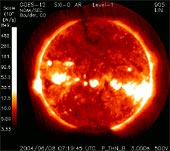|
COMETS EARTH JUPITER KUIPER BELT MARS MERCURY METEORITES NEPTUNE OORT CLOUD PLUTO SATURN SOLAR SYSTEM SPACE SUN URANUS VENUS ORDER PRINTS
PHOTO CATEGORIES SCIENCEVIEWS AMERICAN INDIAN AMPHIBIANS BIRDS BUGS FINE ART FOSSILS THE ISLANDS HISTORICAL PHOTOS MAMMALS OTHER PARKS PLANTS RELIGIOUS REPTILES SCIENCEVIEWS PRINTS
|
Related Documents
Download Options
The NOAA Space Environment Center in Boulder, Colo., used the NOAA GOES-12 satellite space weather instrumentation to observe the passage of Venus in front of the sun. This transit of Venus is the first in 122 years. The GOES observation, using its Solar X-ray Imager, is unique because it records the sunís 2 million degree, outer atmosphere in X-rays. This observation is possible only from space, since Earthís atmosphere blocks out X-rays. The GOES-12 SXI is the only spacecraft to observe this event from space in X-rays. The animation shows the Venus transit as captured by the NOAA Solar X-ray Imager from 12:54 a.m. to 8:44 a.m. EDT. In the NOAA images, Venus appears as a dark disk about 1/30th the sunís apparent diameter. Since the sunís atmosphere or corona extends well above the disk seen in visible light, Venus was visible in silhouette for approximately nine hours, versus the six hours seen from Earth. The path across the disk is from the southeast to the southwest. "Historically, transits of Venus were used to determine the absolute scale of the solar system," said Ernest Hildner, director of the NOAA Space Environment Center. "For SXI, the data taken during the transit of Venus will provide benefits to understanding the SXI instrument performance and thus potentially improving space weather forecasts. There may even be a possibility of using the SXI data to study the atmosphere of Venus," he added. The GOES-12 SXI takes a full-disk image of the sunís atmosphere once every minute. The images are used by NOAA and the U.S. Air Force to monitor and forecast solar flares, coronal mass ejections, coronal holes and active regions. These features are the dominant sources of disturbances in space weather that lead to geomagnetic storms. |
